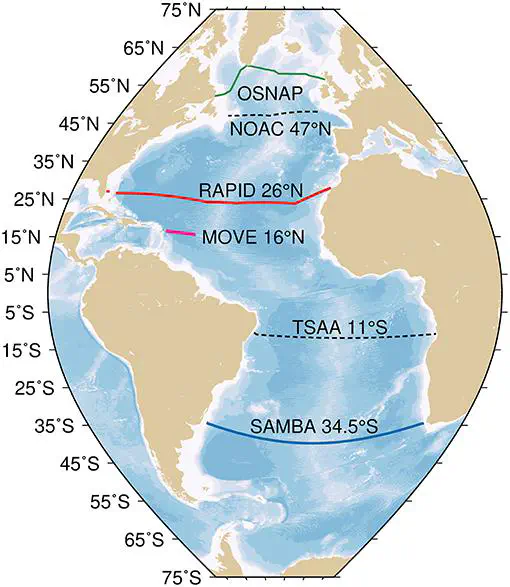Atlantic Meridional Overturning Circulation: Observed Transport and Variability
 Observing arrays in the Atlantic with AMOC transport estimates from OSNAP (green, from 2014), NOAC 47◦N (black dashed, still to be produced), RAPID 26◦N (red, from 2004), MOVE 16◦N (magenta, from 2000), TSAA 11◦S (black dashed, still to be produced), and SAMBA 34.5◦S (blue, from 2009).
Observing arrays in the Atlantic with AMOC transport estimates from OSNAP (green, from 2014), NOAC 47◦N (black dashed, still to be produced), RAPID 26◦N (red, from 2004), MOVE 16◦N (magenta, from 2000), TSAA 11◦S (black dashed, still to be produced), and SAMBA 34.5◦S (blue, from 2009).Abstract
The Atlantic Meridional Overturning Circulation (AMOC) extends from the Southern Ocean to the northern North Atlantic, transporting heat northwards throughout the South and North Atlantic, and sinking carbon and nutrients into the deep ocean. Climate models indicate that changes to the AMOC both herald and drive climate shifts. Intensive trans-basin AMOC observational systems have been put in place to continuously monitor meridional volume transport variability, and in some cases, heat, freshwater and carbon transport. These observational programs have been used to diagnose the magnitude and origins of transport variability, and to investigate impacts of variability on essential climate variables such as sea surface temperature, ocean heat content and coastal sea level. AMOC observing approaches vary between the different systems, ranging from trans-basin arrays (OSNAP, RAPID 26°N, 11°S, SAMBA 34.5°S) to arrays concentrating on western boundaries (e.g., RAPID WAVE, MOVE 16°N). In this paper, we outline the different approaches (aims, strengths and limitations) and summarize the key results to date. We also discuss alternate approaches for capturing AMOC variability including direct estimates (e.g., using sea level, bottom pressure, and hydrography from autonomous profiling floats), indirect estimates applying budgetary approaches, state estimates or ocean reanalyses, and proxies. Based on the existing observations and their results, and the potential of new observational and formal synthesis approaches, we make suggestions as to how to evaluate a comprehensive, future-proof observational network of the AMOC to deepen our understanding of the AMOC and its role in global climate.